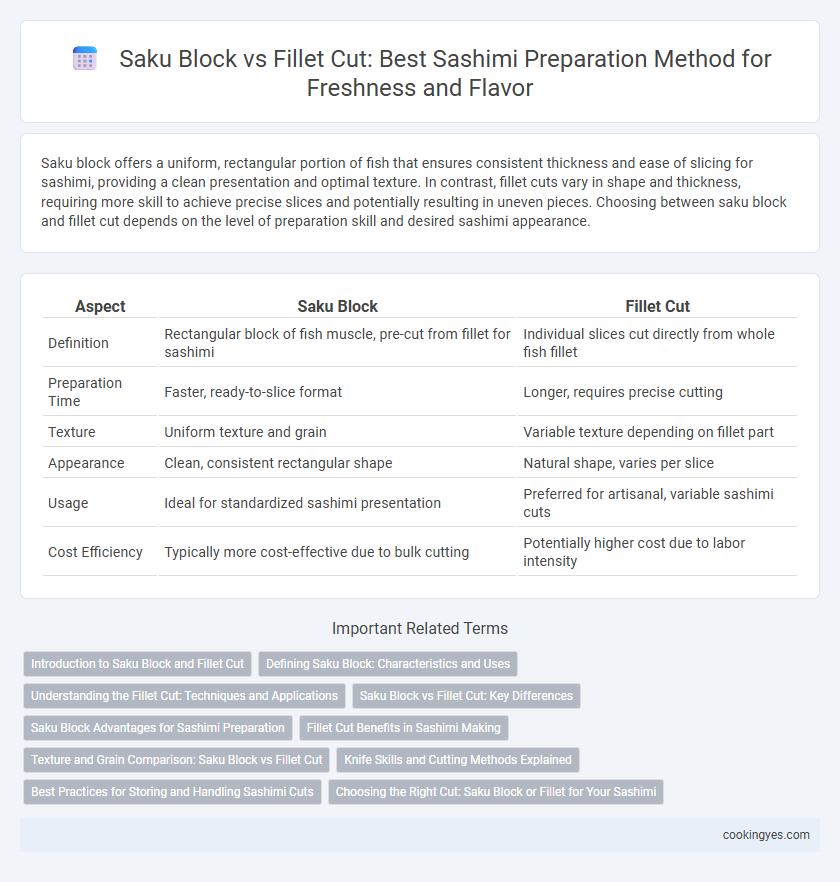Saku block offers a uniform, rectangular portion of fish that ensures consistent thickness and ease of slicing for sashimi, providing a clean presentation and optimal texture. In contrast, fillet cuts vary in shape and thickness, requiring more skill to achieve precise slices and potentially resulting in uneven pieces. Choosing between saku block and fillet cut depends on the level of preparation skill and desired sashimi appearance.
Table of Comparison
| Aspect | Saku Block | Fillet Cut |
|---|---|---|
| Definition | Rectangular block of fish muscle, pre-cut from fillet for sashimi | Individual slices cut directly from whole fish fillet |
| Preparation Time | Faster, ready-to-slice format | Longer, requires precise cutting |
| Texture | Uniform texture and grain | Variable texture depending on fillet part |
| Appearance | Clean, consistent rectangular shape | Natural shape, varies per slice |
| Usage | Ideal for standardized sashimi presentation | Preferred for artisanal, variable sashimi cuts |
| Cost Efficiency | Typically more cost-effective due to bulk cutting | Potentially higher cost due to labor intensity |
Introduction to Saku Block and Fillet Cut
Saku block is a uniformly cut, rectangular portion of fish, typically salmon or tuna, designed for precision and ease in slicing sashimi with consistent thickness. Fillet cut involves preparing the whole side of the fish by removing bones and skin, offering a larger, more textured piece ideal for varied sashimi presentations. Saku blocks streamline cutting processes in high-volume sushi kitchens, while fillet cuts provide greater flexibility for artisanal and intricate sashimi plating.
Defining Saku Block: Characteristics and Uses
Saku block is a precisely trimmed, rectangular cut of fish loin, typically salmon or tuna, favored for sashimi due to its uniform thickness and ease of slicing. This cut ensures consistent portions and a clean presentation, enhancing both texture and flavor in sashimi servings. Saku blocks are preferred over traditional fillet cuts for preparing sashimi because they minimize irregularities and allow chefs to produce aesthetically pleasing, professional-grade slices.
Understanding the Fillet Cut: Techniques and Applications
The fillet cut in sashimi preparation involves carefully trimming the fish into thin, uniform slices that highlight the texture and flavor of the flesh. This technique requires skillful precision to maintain the fish's integrity while ensuring clean edges that enhance presentation and mouthfeel. Unlike the Saku block, which offers convenience and consistency, the fillet cut demands expertise for optimal application in fine dining settings.
Saku Block vs Fillet Cut: Key Differences
The Saku block is a rectangular, pre-cut portion of fish loin, offering uniform thickness and ease of slicing for consistent sashimi presentation, while the fillet cut is a larger, irregular piece directly from the fish's side, requiring further trimming and portioning. Saku blocks reduce preparation time and waste, ensuring optimal freshness and texture, whereas fillet cuts provide more versatility but demand skill for precise slicing. Chefs often prefer Saku blocks for standardized sashimi service and fillet cuts when customizing portions or working with whole fish.
Saku Block Advantages for Sashimi Preparation
Saku block offers superior precision and uniformity for sashimi preparation, ensuring consistent thickness and clean cuts that enhance presentation and texture. Its pre-cut, rectangular shape minimizes waste and reduces preparation time compared to fillet cuts, allowing chefs to work more efficiently. The saku block also preserves the freshness and integrity of the fish, making it the preferred choice for high-quality sashimi.
Fillet Cut Benefits in Sashimi Making
Fillet cut offers precision and uniformity in sashimi preparation, enhancing both texture and visual appeal by producing clean, consistent slices. This method maintains the fish's integrity and freshness by minimizing handling and maximizing the surface area for flavors to be fully appreciated. Chefs prefer fillet cuts as they allow for optimal portion control and elevate the overall dining experience with expertly tailored sashimi presentations.
Texture and Grain Comparison: Saku Block vs Fillet Cut
Saku block offers uniform texture and consistent grain ideal for precise sashimi slicing, enhancing the clean, smooth mouthfeel. Fillet cuts display natural grain variations and softer texture due to muscle fiber separation, offering diverse mouthfeel experiences. Saku blocks provide superior control over portioning and presentation, while fillets yield more delicate, tender sashimi slices.
Knife Skills and Cutting Methods Explained
Saku block and fillet cuts are essential techniques in sashimi preparation, each requiring precise knife skills for optimal texture and presentation. The saku block is a uniform rectangular piece ideal for consistent, thin slices using a Yanagiba knife, ensuring even thickness and smooth cuts. Fillet cutting involves trimming the fish along the natural muscle fibers, demanding careful control to avoid tearing and preserve the fish's structural integrity.
Best Practices for Storing and Handling Sashimi Cuts
Saku blocks offer uniform thickness and are easier to handle, providing consistent quality for sashimi cuts compared to fillet portions. Store sashimi in vacuum-sealed containers at temperatures between 28degF and 32degF to maintain freshness and prevent bacterial growth. Proper handling includes minimizing air exposure and using sanitized, sharp knives to preserve texture and flavor integrity.
Choosing the Right Cut: Saku Block or Fillet for Your Sashimi
Selecting the ideal sashimi cut impacts texture and presentation, with saku blocks offering uniformity and ease for precise knife work, while fillet cuts provide versatility with natural shape and larger portions. Saku blocks, typically from high-quality loins, ensure consistent thickness and reduce waste, making them preferred by chefs aiming for efficiency and aesthetics. Fillet cuts retain more of the fish's original contour, enhancing flavor profile and allowing creative plating, ideal for sashimi enthusiasts seeking authenticity.
Saku block vs fillet cut for sashimi preparation Infographic

 cookingyes.com
cookingyes.com